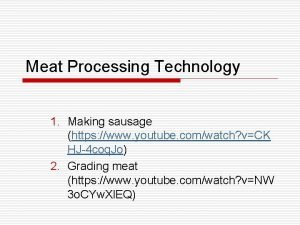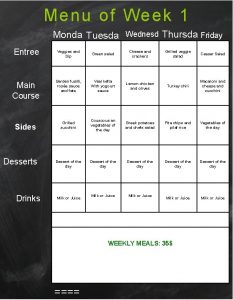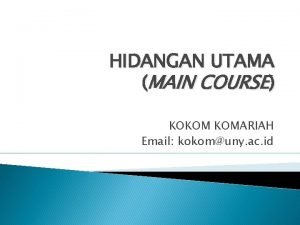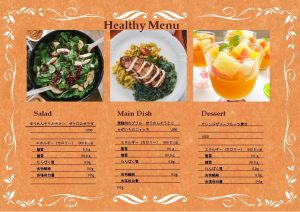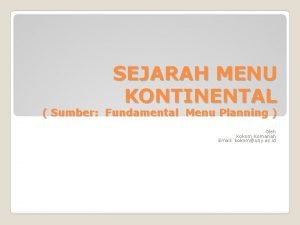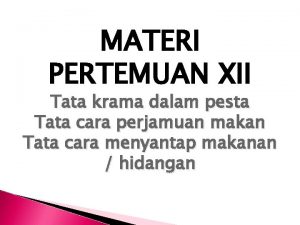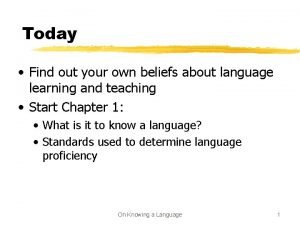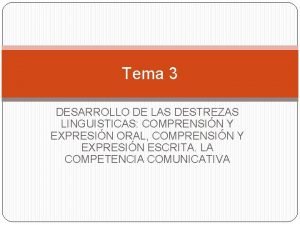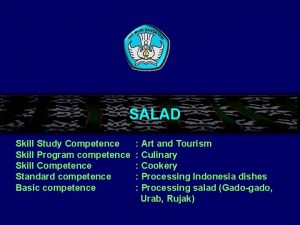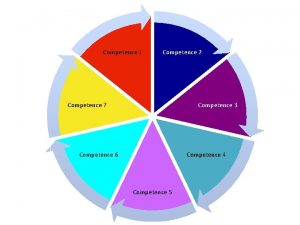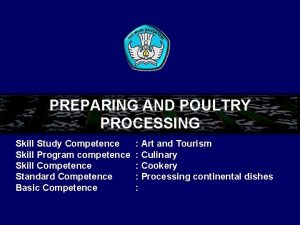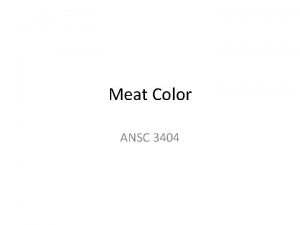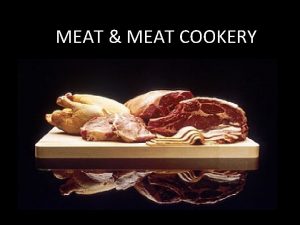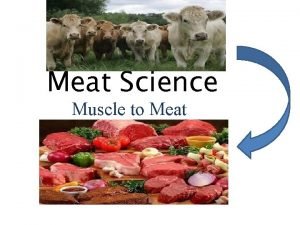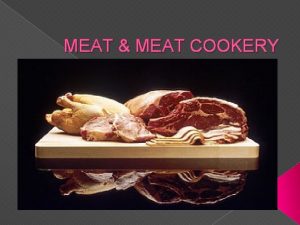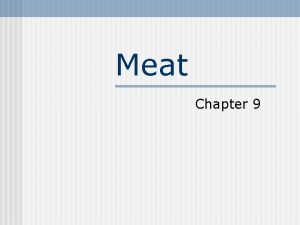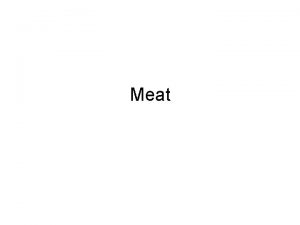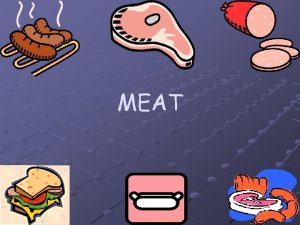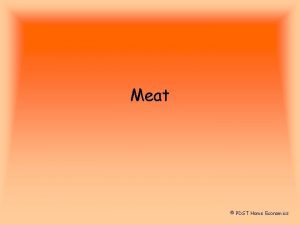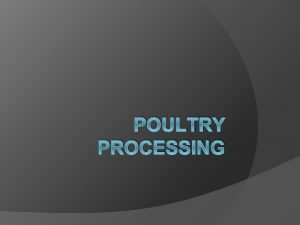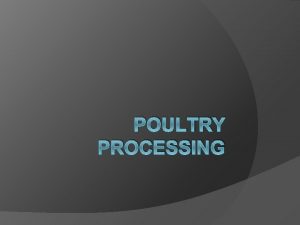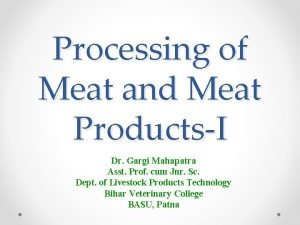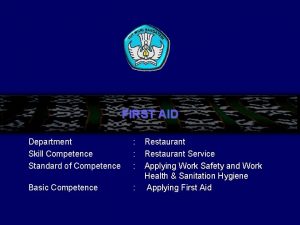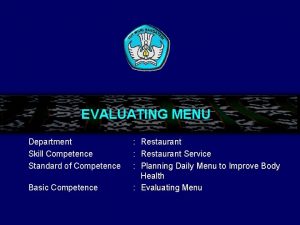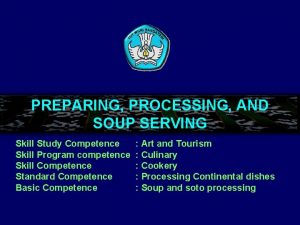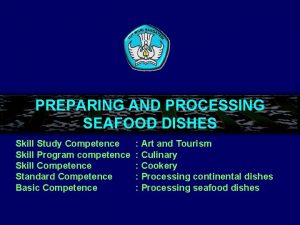PROCESSING MEAT MAIN COURSE Skill Study Competence Skill






































- Slides: 38

PROCESSING MEAT MAIN COURSE Skill Study Competence Skill Program competence Skill Competence Standard Competence Basic Competence : Art and Tourism : Culinary : Cookery : Processing continental dishes : Processing meat dishes

A. Meat is staple supplies, in usage or and vitamins inside, observed from processing or culinary the meaning of “meat” is entire meat taken from animal which has 4 (four) feet that has special protection to get the meat. In the kitchen usually we use only four staple supplies, they are: Beef , Veal (meat from young beef), Lamb, mutton and pork. ar

1. Beef Cows and parts of cows

a. Cows produce meat usually keep just for slaughtering. Except nations requiring ox to be used their energy. Ox will be cut if its energy is not needed again. b. Veal beef used for the processing of obtained from young beef which age up to 3 month and still drink milk from its mother.

Beef

2. Lamb dan Mutton Lamb is a young sheep which age is 1 year, more than that called mutton. Country which produce the greatest lamb are Australia and New Zealand. In processing, selecting lamb and mutton become the important thing, because meat quality will influence food quality.

Lamb and parts of lamb

Criterions of good meat : 1. The color of meat is dark red, soft fibers. 2. White fat and rather hard 3. Young goat the bone is porous. 4. Meat is on the bone

Lamb meat Goat meat

In processing, selecting lamb and mutton become the important thing, because meat quality will influence food quality. Goat meat

3. Pork meat

Pork meat

a. Pork meat contain a lot of fat, color of meat is red whitish. Processing of fork meat usually cooked well done because there a lot of parasites which called trinehines which could be die by heating. b. Pork meat can be got from boar and sow or piglet. Beside meat, fork can be preserved as bacon or ham.

B. Things that should be known before cooking 1. Variation of meat after cutting When the animal cut will happen rigor motis in hours related to tendon contraction and the increasing of flesh/meat hardness. 1. Colored meat variation • • - Purple red become bright red - Bright red become brown or pink will happen if the meat in connection with air. Flavor variation Flavor of meat determined by nitrogen extractive and nonnitrogen. Extent of the meat fiber Meat with a lot of sinews of meat usually obtained from movement of muscle.

C. How to soften meat Softness of meat caused of various kinds, as follows: 1. Muscular tissue; determining meat soften. 2. Fat; fat on muscular tissue enlarge meat soften 3. Age; young beef is softer 4. Parts of meat; every meats have different softness. For example backside meat softer than scrag end.

D. Steps of Cleaning 1. Choose meat based on menu 2. Wipe or clean meat to remove dirt or blood remain on the meat. 3. Cut and dispose thin fat of and other parts that unused. 4. Put meat on place which may water can be dripped

E. Technique of cutting meat Beef meat that comes from a cow which age is a year, a carcass divided into two parts, through backbone, from scrag end to round. Cutting can be divided into two parts just on rib 13 th. Every cutting called quarter that is fare quarter and hind quarter.

F. Meat slice and usage 1. But ; this part consist of top side, silver side, out side and meat in front of bone by removing silverside and top side. This part is good for making braised beef, daging bumbu rujak, dendeng, smoked meat and corned beef. 2. Rump ; this rump divided into rum short cut, rump steak. This part can be cooked as stewed, beef steak, paopiette and so on.

3. Loin ; this part called beef fillet, or tenderloin. Fillet is close by flank and patch on backbone that face to plate. 4. Ribs consist of bone 4 th to 10 th 5. Chuck and Blade 6. Brisket and shin

G. Some ways of cutting 1. Chateaubriand a. Cut or dissociate part of head fillet from middle shares b. Trimming lead the fillet. Urat-urat and also abun dant fat cut. Certain fat in number remain to be needed coherent at steak because can give the aroma and also dampness.

2. Tournedos a. Skinning : fillet having coat of blood-vessel which color is white like fat. This coat is split from fillet before fillet cut become the tournedos. Way of splitting this skin by jabbing filleting knife among meat and skin, knife moved toward head and try there is no meat on the skin fillet.

c. Weighing based on portion 180 – 200 gr. d. Tournedos that has been cut put stand up then slapped around slowly by cattle bat so that fillet growing wide. Fasten the tournedos with the yarn to keep of the tournedos shaped to be circular during cooked

3. Fillet Mignon a. Cut part of athwart tail fillet become the same cutting of length and weight of about 30 – 50 cm b. Flattern, flattern mignon is also made flat like tournedos using cattle bat

4. T Bone Steak T Bone stick taken away from sirloin which still has the bone and fillet (sirloin which still complete). If we check one of joint backbone, hence this bone have 3 finger and 1 holey lump where divisible marrow turt at each backbone cleft look like letter T.

Cutting Technique as follow: a. Put short loin on chopping board, part of fat face the upward and part of backbone face toward body b. Trimming of small part of bone or meat which still on backbone. c. Trimming of Flesh flank. Measure wide of meat about 16 cm from backbone. Remaining of meat on flank cut parallel with the backbone direction

d. Check the coherent fatty tissue on meat e. Cut one of back part horizontally to make easy the next cutting. f. Cut and clean the short loin according to portion determined with the definitive heavy estimate. g. Weighing T Bone stick to know the excess and deficiency the weight h. If the thickness steak more than 2, 5 cm, steak require to be squashed till become thick 2 -2. 5 cm

5. Entrecote come from the word entré that means between, and cote means a part of meat among flank. The cutting technique as follows: a. Put sirloin on chopping board with the part of fat face downwards b. Cut the yellow thick tendon/blood-vessel on backbone

c. Cut the thin tendon/blood-vessel on meat. This tendon/Blood-Vessel coat is cut one by one d. Measure the wide sirloin about 16 cm from backbone e. Cut one of back part horizontally, hereinafter sirloin steak cut athwart, start from back part which have been flatten cut

6. Chop Entrecote come from the word entré that means between, and cote means a part of meat among flank. The cutting technique as follows: a. Put sirloin on chopping board with the part of fat face downwards b. Cut the yellow thick tendon/blood-vessel on backbone

c. Cut the thin tendon/blood-vessel on meat. This tendon/Blood-Vessel coat is cut one by one d. Measure the wide sirloin about 16 cm from backbone e. Cut one of back part horizontally, hereinafter sirloin steak cut athwart, start from back part which have been flatten cut

7. Cutlet cut rib consisted of the rib and meat/flesh. On cutting cutlet , rib still stick on. If this rib is eliminated hence this cutting cannot be referred as cutlet again Technique of cutting, as follows: a. Put rib on chopping board with the bone face toward body b. Cut trim part of abundant edge

c. Cut part of flesh/meat or part of bone which still on backbone d. Cut part of abundant edge e. Cut one of back part for the portioning of f. On cutlet with the cutting between rib. 1 cutlet weight 180 – 250 gram g. Squashing cutlet till the thickness is 1. 5 – 2 cm

H. Guiding Protion 1. Chateaubriand To accommodate the portion to be served as according to what habit accepted by a guest is needed a guiding portion. Beside that the successful of kitchen in estimating/calculating the ingredients needed a guiding portion. Even though each company is entitled to determine the portion to be served to the guest.

I. Sample of Beef dishes Beff Steak Maitree D’hotel Rump Steak T. Bone Steak Sirloin Steak Grilled Rib Steak

J. Steps of making sate of Beef

K. Various Kinds of Sate


L. Sauce Saus Kecap Saus Kacang
 Give 5 market forms of poultry
Give 5 market forms of poultry Hard skills and soft skills
Hard skills and soft skills Meat processing technology
Meat processing technology T junction english bond
T junction english bond Course title and course number
Course title and course number Chaine parallèle muscle
Chaine parallèle muscle Q processing course
Q processing course Importance of study skills
Importance of study skills Top.down processing
Top.down processing Gloria suarez
Gloria suarez Bottom up processing example
Bottom up processing example Neighborhood processing in image processing
Neighborhood processing in image processing Secondary food processing
Secondary food processing Point processing operations in image processing
Point processing operations in image processing Histogram processing in digital image processing
Histogram processing in digital image processing Parallel processing vs concurrent processing
Parallel processing vs concurrent processing Neighborhood processing in digital image processing
Neighborhood processing in digital image processing What is point processing in digital image processing
What is point processing in digital image processing Morphological
Morphological Top down vs bottom up processing
Top down vs bottom up processing Interactive processing
Interactive processing L'entree de course
L'entree de course Hidangan main course
Hidangan main course Main course menu
Main course menu Susunan menu kontinental
Susunan menu kontinental Main course kontinental dari ayam
Main course kontinental dari ayam Tata krama saat makan dalam jamuan pesta
Tata krama saat makan dalam jamuan pesta Alabama course of study math
Alabama course of study math Alabama course of study math 2019
Alabama course of study math 2019 Be going to form
Be going to form Finding the main idea why were canals built?
Finding the main idea why were canals built? Void main int main
Void main int main Competence vs performance in linguistics
Competence vs performance in linguistics La compétence définition
La compétence définition Grammatical competence
Grammatical competence 4 destrezas linguisticas
4 destrezas linguisticas Diversity competency
Diversity competency Idd training and competence requirements
Idd training and competence requirements Structuralism to transformational generative grammar
Structuralism to transformational generative grammar


